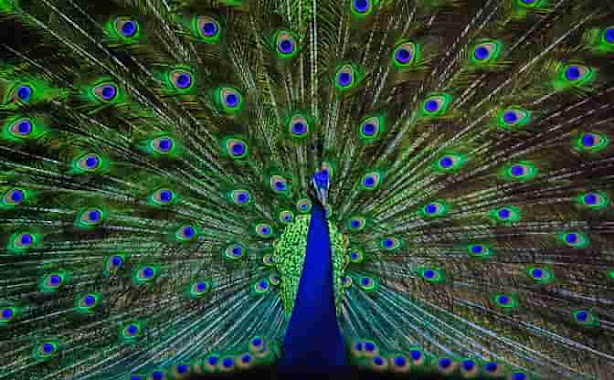Essay on Peacock

Peacock,
commonly known as peafowl is a beautiful, large, colorful bird. Male peafowl is
called peacock and female peafowl is called peahen and the babies are called
peachicks. Both are also called peacock. There are three types of peacocks:
Blue peacock, Green peacock and Congo peacock. Among the three species, Indian peafowl or blue
peafowl is the largest and heaviest.
Description
of Peacock
Peacock is
one of the most beautiful and fascinating bird with a huge colorful tail,
magnificent feathers and crests.
The blue
male peacocks or male peafowls are metallic blue in colour, the feathers of
their head are blue in color which are short and curled. They have fan-shaped
crest on the head that is made of feathers with bare black shaft and tipped
with bluish-green webbing.
The both
sides of their head have greenish blue feathers and have white patch around the
eyes which are formed by bare white skin. Their back is covered with scaly
bronze-green feathers with black and copper markings.
The color of
their tail is dark brown and has only 20 feathers. Their tail is also called
train which is an iridescent arrangement of colorful feathers. The train is
made up of more than 200 feathers which have an eye spot at the end of every
feather, but some feathers have crescent shaped black tip at the end. The
length of train of male peacock is 1m to 1.3m. The tail feather of a peacock
can be 6feet long which makes up 60% of the bird's body length.
The peahen
has brown coloured head and has a crest on their head but the tips of the crest
are chestnut edged with green. Their neck feathers are metallic green and
breast is dark brown glossed with green but the under part is white in color.
Peacocks
have long and strong greyish-brown legs with buff coloured thighs and have a
spur on the both legs along the hind toes.
Green
peafowl or green peacock is also known as Dragon bird. Male peacock has iridescent metallic
green coloured plumage. Their back, neck and mantle are covered with scaly
green feathers. Their
emerald green tail feathers have a series of eye-spots. Peahen has dull
grey-green feathers and has no train. They have yellow crescent beside the ears
and light blue patch under the eyes.
They have
metallic bluish-green feathers, bare red neck, black tail with 14 feathers and
grey feet. Their crest is made with vertical white hair-like feathers.
White
peacock is rare. The
white peacock has blue eyes but their feathers have no pigmentation.
Habitat
of peacock
India and
Sri Lanka are the homes Blue peacock and Green peacock lives in Java and
Myanmar. Congo peacock is found in Congo basin, central Africa.
In India, peacock
lives in south-east Indus River, east Assam, Indian Peninsula, south Mizoram,
Jammu and Kashmir. Blue peacock also found in eastern Pakistan, Sri Lanka, and
Bangladesh. Peacocks are found in bamboo, grasslands, savanna, scrub and
farmland edge.
Behavior of Peacock
Peacocks or
peafowls are omnivores. Their favorite foods are small snakes, small creatures
like frogs, lizards, insects, ants, termites, locust, leaves, fruits,
vegetables, flower petals, seeds, grains etc. In spring, the male peacocks display
their courtship by spreading their iridescent train in a fan shape and shake
the feathers to produce a rattling noise for attracting peahen’s attention.
The peahen
scrapes a hole in the ground to build her nest, which is hidden in the wood or
leaves and bushes and lays one or two clutches of eggs. Each clutch contains 4 to 8 eggs and
the color of the eggs is ivory or tan. After 28 to 30 days, the chicks come out of the eggs. The
chicks are called peachicks. They are yellow or brown in color and have
feathers on their bodies.
Peafowl or
peacock can live 10 to 25 years but in captivity, they can live 40 to 50 years.
Threats
to Peacock
Peacocks are
threatened by extinction, smuggling, hunting and poaching. The poachers kill
the peacock for their beautiful feathers and meat. Due to deforestation,
peacocks do not get sufficient food, breeding habitat, shelter and pushes them
towards extinction. Green
peacock and Congo peacock are also considered to be endangered.
Conclusion
The peacock,
a symbol of beauty, wealth, immortality and pride, has always had a special
place in the kingdom of the beast. Because of its beauty and grace, the peacock was declared as the National Symbol of India in 1963. Congo peacock is the national bird of the Democratic
Republic of Congo.


.jpg)














0 Comentarios:
Post a Comment
Please do not use any abusing words or enter any spam links in the comment box